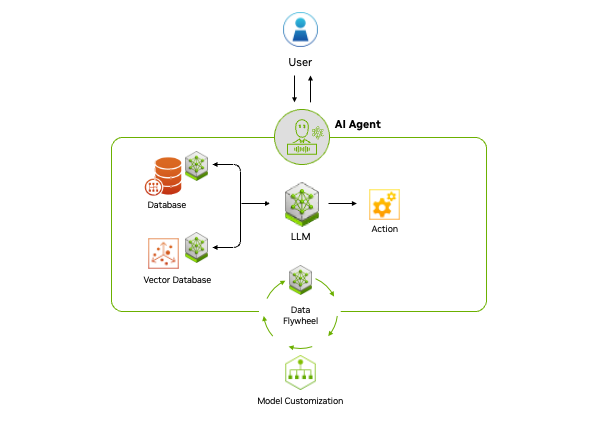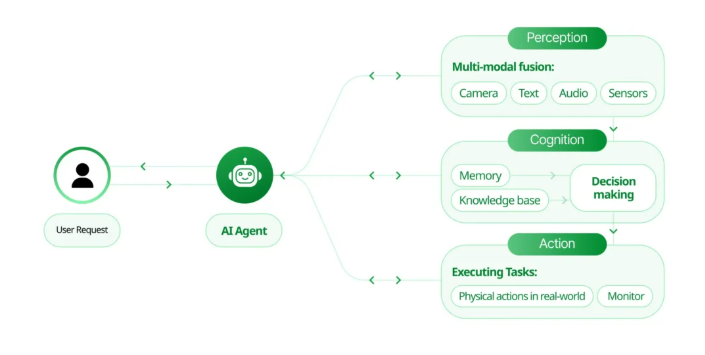Agentic AI Action Layer: Tools, APIs & Execution Engines for True Autonomy

Audio : Listen to This Blog.
Agentic Artificial Intelligence (AI) isn’t just about language processing or prediction—it’s about taking action. The agentic AI framework emphasizes the distinction between agentic AI as a broader framework and AI agents as specific components within that framework. While traditional AI responds to queries, Agentic AI sets goals, executes tasks, and adapts its strategies in real time. Agentic AI operates by discussing its architecture and the functionality of autonomous software components called ‘agents.’ These agents integrate advanced technologies, such as machine learning and natural language processing, enabling them to learn from data and collaborate effectively to complete complex tasks across different industries. The powerhouse behind this functionality is the Action Layer.
Image Source: k21academy
This blog breaks down the Action Layer into its core working parts—tools, APIs, and execution engines—and explains how they combine to create truly autonomous systems.
Introduction to Agentic AI

Source: NVIDIA
Agentic AI represents a shift from passive automation to systems that can autonomously perceive, decide, and act. These intelligent agents use real-time data and user input to understand context and execute specific tasks aligned with customer needs. By streamlining software development and enabling dynamic workflows, agentic AI redefines how we build and interact with modern digital systems.
What Is the Agentic AI Action Layer?
The Action Layer enables Agentic AI to move from thinking to doing. It executes commands, initiates workflows, and interacts with external environments. As an agentic AI system, it allows AI to manage complex tasks autonomously, such as optimizing logistics and supply chain operations. Whether it’s updating a database or sending a message, the Action Layer ensures the agent completes tasks that drive outcomes. Without it, the AI is just a passive observer. With it, the AI becomes an autonomous operator capable of handling real-world tasks.
Key Concepts
Agentic AI is built on several key concepts, including autonomous agents, natural language processing, and machine learning. AI agents gather data, operate independently, and perform complex tasks, making them ideal for tackling complex challenges. Generative AI, a type of AI that generates original content, is also a crucial component of agentic AI. Agentic AI systems can interact with external tools and software development platforms, enabling them to execute tasks and make decisions without human oversight. This technology can revolutionize business processes, from customer service inquiries to creative work.
Tools: Purpose-Built Functions for Autonomous Agents
Tools are specialized functions designed to help autonomous agents carry out specific tasks efficiently and accurately. They enable agentic AI systems to respond to user input precisely, aligning actions with customer needs in real time.
Small Components, Big Results
Agentic AI tools are highly specialized components built to perform one function well, like retrieving customer data or summarizing a document. Their limited scope makes them easy to maintain, test, and reuse across different workflows. Tools are often packaged as lightweight scripts or modules that can be executed independently when required. This modularity allows developers to combine tools in various sequences to create complex agent workflows. The result is a flexible system where tasks can be rapidly built and iterated.
Stateless and Functionally Pure by Design
Stateless tools don’t store information between tasks, which means their behavior is predictable and repeatable. AI agents learn and improve over time by utilizing a feedback loop known as a data flywheel, which enhances their functionality and effectiveness. This makes them ideal for scalable systems where multiple tasks are run in parallel. Functional purity ensures tools behave consistently, producing the same output for the same input, eliminating hidden side effects. This also simplifies debugging and enables safe reuse across environments. These principles keep agent workflows clean, reliable, and easy to scale.
APIs: External Access That Extends Agent Reach
APIs provide external access points that allow intelligent agents to interact with third-party services, extending their capabilities beyond internal systems. This connectivity enables agentic AI to perform more complex, customer-centric tasks by leveraging diverse data sources and functionalities.
Connecting to the Outside World

APIs serve as the interface between Agentic AI and external software systems. These could be third-party tools, internal platforms, or public web services. APIs let agents pull real-time data, trigger actions in SaaS platforms, or interact with internal enterprise applications. For example, an agent could pull financial data from Stripe, create tasks in Jira, or send updates via Slack—all through API calls. This connection to live systems and integration with existing systems makes Agentic AI solutions operationally powerful.
Enterprise-Grade Integrations in Action
Practical use cases for APIs are growing fast. AI agents enhance customer interactions by improving response times and increasing customer satisfaction through automating routine communications and facilitating more dynamic self-service options. Agents might use Slack APIs to send task updates or receive human-in-the-loop approvals. Stripe APIs enable autonomous billing and payment validation workflows. GitHub APIs allow code agents to create PRs, manage issues, or deploy builds. Even legacy systems can be integrated with custom REST APIs, expanding the agent’s role in enterprise ecosystems. These integrations make agents functionally valuable across departments.
Security Can’t Be an Afterthought

Every API integration introduces potential security risks, especially in autonomous environments. Early chatbots, for example, relied heavily on pre-defined rules and scripted responses, which limited their ability to manage complex interactions and adapt to unexpected inputs. However, modern AI technologies have advanced beyond these limitations, allowing for more flexible, autonomous, and intelligent interactions. Agents must be authenticated using secure tokens or OAuth protocols, with strict permissions on what they can access or modify.
Input validation is also key to preventing injection attacks or data corruption. Rate limiting protects systems from overload due to poorly configured loops or retries. Visibility into every API call ensures traceability and auditability for compliance.
Use OpenAPI Specs for Predictable Integrations
OpenAPI (Swagger) specifications help make APIs machine-readable and agent-friendly. These specs define endpoints, input/output formats, and authentication methods in a consistent structure. Developers can auto-generate client libraries, and agents can dynamically adapt to new APIs without manual configuration. This speeds up development and standardizes how agents communicate across services. OpenAPI is a vital tool in building scalable Agentic AI architectures.
Execution Engines: The Control Center of Agent Workflows
Execution engines act as the control center of agent workflows, coordinating actions based on real-time data, user input, and predefined logic. They translate high-level decisions made by intelligent agents into precise, automated steps that fulfill specific tasks aligned with customer needs. By managing task execution, error handling, and resource allocation, execution engines are key to ensuring reliable and efficient agentic AI work.
Orchestrating Task Sequences for Complex Tasks
Execution engines manage how agents plan, prioritize, and perform actions within complex workflows. They decide task order based on logic, context, and state. This allows agents to complete multi-step workflows like “gather data → analyze → report.” These engines also handle branching logic, such as retrying a task or switching to a fallback plan. Without this orchestration layer, agents would behave linearly and brittlely.
Built-In Error Handling and Recovery

Agents operating in dynamic environments will fail. Agents must be adaptable and responsive in complex and dynamic environments, making robust error handling crucial. Execution engines provide structured error handling, allowing for retries, timeouts, or switching to alternate workflows. This reduces system fragility and improves reliability in production use cases. Well-managed error handling also helps maintain user trust, especially in customer-facing applications. It’s essential for building agents that can operate unsupervised.
Maintaining State and Context
To act intelligently, agents need memory—both short-term and long-term. Execution engines manage this state, updating internal knowledge as each task completes or changes. This state processes data for goal tracking, replanning, and improving accuracy. Without effective state management, agents lose context and repeat mistakes. For long-lived agents, memory is not optional—it’s foundational.
Open-Source Execution Engines to Know
Several emerging execution frameworks power agent workflows. LangGraph uses a graph-based routing model, supporting loops, conditions, and memory tracking. AutoGPT uses a TaskManager to decompose complex goals and assign subtasks to sub-agents. CrewAI and MetaGPT introduce multi-agent orchestration, where different roles handle tasks concurrently. These engines offer flexible control layers, from simple agents to autonomous multi-agent systems.
Key Features and Benefits
The key features of agentic AI include its ability to handle complex tasks, operate in dynamic environments, and make decisions based on data-driven insights. Agentic AI systems can also learn from past interactions and adapt to new situations, making them highly effective in performing repetitive tasks. The benefits of agentic AI are numerous, including improved employee productivity, enhanced customer engagement, and increased efficiency in software development.
Agentic AI-powered agents can also analyze vast amounts of data, providing valuable insights and informing strategic initiatives. By leveraging agentic AI, organizations can gain a competitive edge and stay ahead of the curve in today’s fast-paced business landscape.
Decision Making and AI Models
Agentic AI systems use advanced AI models, including machine learning algorithms and knowledge representation, to make decisions and perform tasks. These models enable agentic AI systems to analyze data, identify patterns, and make predictions, allowing them to operate independently and make decisions with minimal human intervention. The decision-making process in agentic AI is based on a combination of data-driven insights, past interactions, and specialized models, ensuring that AI agents can handle complex scenarios and make informed decisions.
By leveraging these advanced AI models, agentic AI systems can optimize processes, improve performance metrics, and drive business success.
Agentic AI Applications
Agentic AI has many applications, from customer service and software development to healthcare and finance. AI agents can perform complex tasks, such as analyzing patient data and providing personalized recommendations, or streamline administrative tasks, such as scheduling appointments and managing records. Agentic AI can also enhance the creative process, generate new ideas and content, and improve customer engagement, providing personalized experiences and support.
Implementing agentic AI can unlock new opportunities, drive innovation, and keep organizations ahead of the competition. Whether used to tackle complex challenges or perform simple tasks, agentic AI is revolutionizing how businesses operate and interact with customers, employees, and partners.
Key Considerations for Building the Action Layer
When building the Action Layer, it’s essential to define clear interfaces between tools, APIs, and execution engines to enable intelligent agents to perform specific tasks effectively. Modularity and extensibility should be prioritized to adapt to evolving customer needs and support diverse user input across agentic AI systems. Equally important is implementing strong security and orchestration controls to ensure reliable, autonomous operations at scale.
Lock Down Security First
Agents can trigger decisive actions, so security must be built into every component. Agentic AI can significantly enhance business operations by automating workflow management and customer service tasks, ultimately alleviating the burden on human employees. Use secrets managers, encrypted token stores, and tight access scopes to control what agents can do. Validate every input and sanitize output to prevent malicious behavior or data leaks. Log all actions for traceability, especially in regulated industries. Without these measures, an agent becomes a vulnerability instead of an asset.
Instrument Everything for Observability
You can’t fix what you can’t see. Observability tools should track every step the agent takes—tool use, API response times, error rates, and decision points. By providing real-time insights, these tools empower companies to make smarter, data-driven decisions by leveraging a comprehensive view of their operations. Real-time dashboards make it easier to identify failures or inefficiencies. Logs should show what the agent did and why it made those decisions. Full observability is critical for debugging and improving agent behavior.
Design for Scale from Day One in AI Systems
Agentic systems need to scale with demand. Agentic AI impacts various job functions by enhancing efficiency and automating tasks, turning data into actionable knowledge. Stateless tools and microservices allow easy containerization and load balancing. APIs should be ready for high concurrency and include retry/backoff logic. Execution engines should support distributed task queues and sharding if needed. Building with scale in mind avoids painful rewrites later.
Build Feedback Loops Into the System
Autonomous agents need the ability to self-correct. Tools and execution flows should support validation checks, self-assessment, and replanning steps. If an outcome isn’t what was expected, the agent should adapt—not just fail silently. These feedback loops enable learning and long-term accuracy improvements. Feedback loops are crucial for ai innovation by enabling continuous improvement and adaptation. This is where Agentic AI begins to move beyond automation into self-optimization.
Why the Action Layer Is the Backbone of Agentic AI
Without a functional Action Layer, even the smartest Agentic AI is just a glorified chatbot. A key characteristic of agentic AI is its ability to think and act autonomously, which the Action Layer enables. The Action Layer gives it the ability to perform tasks, adapt to context, and deliver results. It transforms knowledge into action across tools, APIs, and systems. This is where the AI moves from reactive to proactive. Building this layer right determines whether your agents stay as assistants—or become true operators.
Final Take: Start With the Layer That Delivers Results
Agentic AI systems are only as good as their ability to act. These systems transform how humans interact with technology using real-time data to understand user goals and preferences, facilitating more autonomous and insightful interactions. By analyzing user input in context, intelligent agents can align more closely with customer needs, automatically executing specific tasks without constant human oversight.
This capability is central to how agentic AI works and changes the game—it helps streamline software development by reducing repetitive coding, automating testing, and enabling continuous deployment. The Action Layer—built from tools, APIs, and execution engines—is where reasoning meets reality. If you’re serious about deploying autonomous agents, this is where your architecture should start. Prioritize modular design, robust security, and dynamic orchestration. That’s how you build agents that don’t just think—they deliver.
